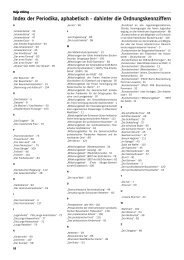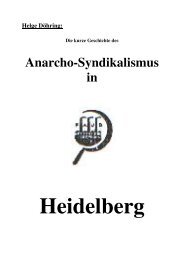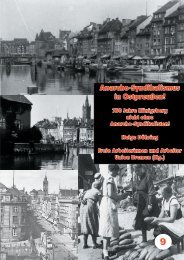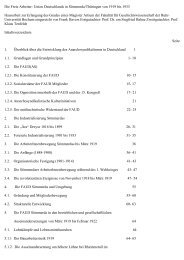Syndicalism and Anarcho-Syndicalism in Germany - Institut für ...
Syndicalism and Anarcho-Syndicalism in Germany - Institut für ...
Syndicalism and Anarcho-Syndicalism in Germany - Institut für ...
- No tags were found...
Create successful ePaper yourself
Turn your PDF publications into a flip-book with our unique Google optimized e-Paper software.
<strong>Syndicalism</strong> <strong>and</strong> <strong>Anarcho</strong>-<strong>Syndicalism</strong> <strong>in</strong> <strong>Germany</strong>: An Introductionsyndicalists found themselves faced with yet another powerful opponent, <strong>in</strong> additionto the capitalists. While the central unions made great displays of patrioticread<strong>in</strong>ess <strong>and</strong> commitment, the syndicalists were persecuted by state officials <strong>and</strong>opposed by social democrats for their vehement anti-war stance. Meanwhile, anarchisttheory, personified by Proudhon, Kropotk<strong>in</strong> <strong>and</strong> Gustav L<strong>and</strong>auer, ga<strong>in</strong>edtraction <strong>in</strong> <strong>Germany</strong>.3. The mould<strong>in</strong>g of <strong>Anarcho</strong>-<strong>Syndicalism</strong> after the First WorldWarFollow<strong>in</strong>g the First World War the FVDG reconstituted itself. Largenumbers of workers, disappo<strong>in</strong>ted by the SPD’s support for the war, flocked toalternative organizations, among them the FVDG, which <strong>in</strong>creased its numbersten-fold with<strong>in</strong> a year, reach<strong>in</strong>g approximately 60,000. This organization offereda real form of worker self-management, which was perceived by the central tradeunions as a threat to their aims of social partnership. Syndicalists, along withcouncil communists, were the bogeymen of social democracy, not just because theyattracted large numbers of new members (up to 150,000 by 1922), but also becausethey developed a more concrete concept of their organization <strong>and</strong> theory.This manifested itself <strong>in</strong> the “Pr<strong>in</strong>zipienerklärung des Syndikalismus,” [Declarationof the pr<strong>in</strong>ciples of syndicalism] written by the then up-<strong>and</strong>-com<strong>in</strong>g theoristRudolf Rocker <strong>and</strong> presented <strong>in</strong> 1919 to the 12th Congress of the FVDG, whichadopted it with few alterations. In contrast to social democracy, which imposed themediat<strong>in</strong>g structure of the party upon the workplace organizations, the syndicalistsrecognized the dangers that could result from such dualism. Consequently, they putaside the theoretical division of economics <strong>and</strong> politics with the aim of enabl<strong>in</strong>g theproletariat to govern itself on all levels. In accordance with these claims the syndicalistshad to organize themselves <strong>in</strong> all realms of life. Society was to both rule <strong>and</strong>carry all responsibility for itself, for “freedom exists only where it is carried forthwith the spirit of personal responsibility,” as Rudolf Rocker put it. In concurrencewith Marxist theory, the syndicalists held that economics represented the essentialfoundation of social life, <strong>and</strong> that organiz<strong>in</strong>g efforts needed to concentrate on thetwo ma<strong>in</strong> actors with<strong>in</strong> the economic sphere: producers <strong>and</strong> consumers.4. A clear alternative to authoritarian Communism: The FreeWorkers’ Union of <strong>Germany</strong>As a result of its theoretical outlook, the FVDG was renamed the FreeWorkers’ Union of <strong>Germany</strong> <strong>in</strong> 1919 <strong>and</strong> reorganized <strong>in</strong>to Industrial Federationson one h<strong>and</strong> <strong>and</strong> Workers’ Communities (Arbeitsbörsen) on the other. The Indus-7








